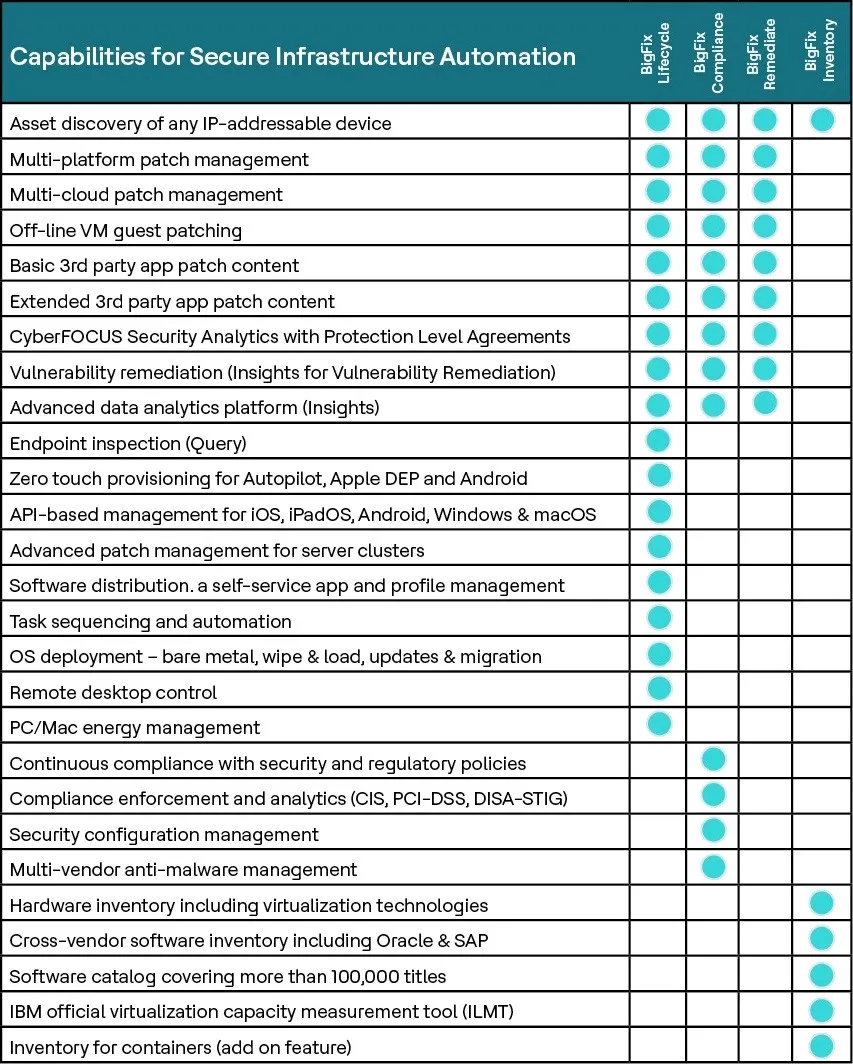In today’s fast-paced digital landscape, businesses rely heavily on their IT infrastructure to drive efficiency, enhance productivity, and deliver seamless customer experiences. Managing diverse datacenter environments has become a top priority for organizations — and with an increasing number of operating systems being used in these environments, the complexity of datacenter management has grown exponentially. This presents a unique set of challenges that administrators must navigate to ensure smooth operations and efficient utilization of resources.
This is where BigFix comes in — offering organizations a comprehensive solution to streamline IT operations and ensure the optimal performance of their secure environment.
Case Study: How Berkshire Bank Used BigFix for Vulnerability Remediation
BigFix is a robust and versatile platform that provides automation capabilities for managing and securing infrastructure. With its centralized management console and powerful automation tools, BigFix enables IT administrators to automate repetitive tasks, enforce compliance policies, patch vulnerabilities, and monitor system health—all from a single interface. Berkshire Bank adopted BigFix Insights for Vulnerability Remediation (IVR) to speed remediation and reduce vulnerabilities by 90%.
Key Benefits of BigFix Secure Infrastructure Automation Include:
Enhanced Efficiency and streamlined IT Operations: By automating routine tasks such as software deployments, patch management, and configuration changes, BigFix significantly reduces manual effort, enabling IT teams to focus on more strategic initiatives. This automation streamlines operations, improves response times, and increases overall productivity.
Comprehensive Endpoint Security & Vulnerability Remediation: Cybersecurity threats are a constant concern for businesses. BigFix helps strengthen secure infrastructure security by automating vulnerability scanning, identifying and patching security vulnerabilities, and enforcing compliance policies across the entire environment. This proactive approach helps minimize the risk of data breaches and system compromises. BigFix’s CyberFOCUS Analytics enables IT operations to simulate the business impact of vulnerability remediation while getting ahead of the biggest threats. They can also take a more active role in enterprise endpoint security by defining and measuring their performance in protecting the organization. Some of the key benefits include: Minimizing business interruptions by simulating the impact of remediating specific vulnerabilities on the enterprise attack surface, using Protection Level Agreements (PLAs) to define and measure remediation efforts against agreed-to targets defined by business stakeholders and IT Operations, and prioritizing remediation efforts by visualizing the magnitude of the attack surface against your PLA to address underlying vulnerabilities with respect to time.
Simplified Management with Intelligent Automation: With its centralized management console, BigFix provides a unified view of the entire secure infrastructure, allowing administrators to monitor and manage diverse endpoints from a single platform. This simplification of management tasks reduces complexity, improves visibility, and enables better control over the infrastructure.
Scalability, Flexibility & Centralized Control: BigFix is designed to scale effortlessly, accommodating diverse secure environments and growing organizational needs. Its flexibility allows for customization and integration with other tools, making it a versatile solution for businesses of all sizes and industries.
Proactive Monitoring & Maintenance for IT Infrastructure: BigFix’s monitoring capabilities enable real-time visibility into health and performance, helping IT teams proactively identify and address issues before they impact the business. This proactive approach minimizes downtime, ensures optimal performance, and enhances the end-user experience.
Ensure Compliance & Auditing with Automated Solutions: BigFix automates the enforcement of compliance policies, ensuring adherence to industry regulations and internal security standards. The platform provides robust auditing and reporting features, simplifying compliance management and facilitating regulatory assessments.

Real-World Use Cases: How Automation Solves IT Challenges
Infrastructure automation plays a critical role in IT operations by addressing complex challenges across various scenarios. Organizations dealing with data-center migration, mergers and acquisitions, or expanding their remote work capabilities benefit from streamlined processes, enhanced visibility, and reduced operational overhead.
In use cases such as cloud infrastructure automation, automation and analysis tools simplify workload management, speed up deployments, and enhance security protocols. Businesses can proactively monitor system health, enforce policies, and respond to incidents in real time. This unified approach to infrastructure automation and analytics helps reduce risks and improve the efficiency of IT operations, making it easier to adapt to changing business requirements.
Best Practices for Implementing Infrastructure Automation
By following the practices below, organizations can implement infrastructure automation efficiently:
Successfully implementing infrastructure automation requires a strategic approach, beginning with a clear implementation plan that is aligned with organizational goals. Companies should start by conducting a thorough risk assessment and creating an accurate asset inventory, which forms the foundation for setting priorities and defining policies.
A phased rollout, starting with a pilot project, allows teams to test tools, refine workflows, and gain stakeholder buy-in. Training human resources and technical teams ensures everyone is equipped to manage and maintain automation systems, reinforcing adoption.
Continuous monitoring is essential to identifying issues early, while regular updates to automation policies help ensure processes remain aligned with evolving threats and compliance requirements. A well-documented deployment schedule helps standardize operations and reduce errors, which helps in long-term success.
Conclusion: The Future of IT is Automated
In an era of rapid digital transformation, businesses need a robust and agile IT infrastructure that can effectively support their operations. BigFix secure infrastructure automation offers organizations a comprehensive solution to streamline IT operations, improve security, and optimize the performance of their secure environments. By automating routine tasks, enforcing compliance policies, and proactively monitoring system health, BigFix empowers IT teams to focus on strategic initiatives, reduce risks, and drive efficiency. Embracing BigFix can lead to enhanced productivity, better resource utilization, and a more resilient and secure infrastructure. For complete information on BigFix secure infrastructure automation, visit here. For general information, visit HCL BigFix or contact us.
Frequently Asked Questions
This new FAQ section is designed to directly answer the "Questions to Answer" provided by Semrush, ensuring high relevance and authority.
What are the primary benefits of infrastructure automation for businesses?
Infrastructure automation helps businesses work smarter. It improves productivity, reduces costs, minimizes errors, and enhances scalability. It also improves scalability, making it easier to grow, while strengthening cyber resilience against security threats.
Which tools are most effective for infrastructure automation and why?
Tools like HCL BigFix stand out because they offer centralized management, quick vulnerability remediation, and clear reporting. With a single agent handling multiple tasks, organizations can have better compliance and simplify their entire IT landscape.
How can organizations begin implementing infrastructure automation?
To begin with the implementation of infrastructure automation, you need to define a clear implementation plan that supports your business objectives, then roll it out in phases. A pilot project helps test tools before full deployment, and involving all teams early ensures smoother adoption with proper team training and stakeholder buy-in.
What best practices should be followed for successful automation?
Here are a few best practices that should be followed for successful infrastructure automation:
- Keep continuous monitoring in place to spot issues early.
- Conduct regular risk assessments and update your automation policies accordingly.
- Follow a structured deployment schedule for consistency.
- Document processes clearly to ensure teams can adapt quickly.
What are common challenges faced during the implementation of infrastructure automation?
Some common challenges faced during the implementation of infrastructure automation are outdated legacy systems, lack of skills, and natural resistance to change. Security concerns, vendor lock-in, and increased complexity can also slow down adoption if not planned carefully.
How do automation tools help with vulnerability remediation?
Infrastructure automation tools like HCL BigFix make managing security patches easier, reducing potential threats and shrinking the attack surface. Features like CyberFOCUS Analytics help prioritize vulnerabilities, so teams can quickly address the most critical issues before they’re exploited.
Start a Conversation with Us
We’re here to help you find the right solutions and support you in achieving your business goals.








